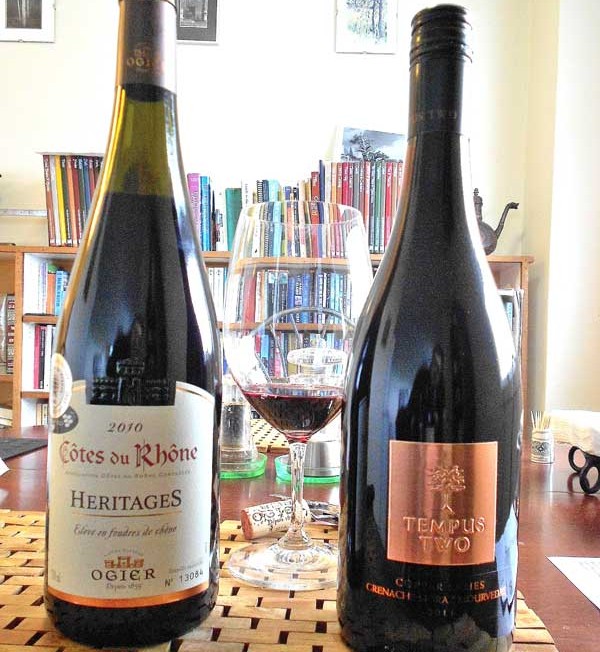A couple of decades ago, a number of Australian winemakers came to the conclusion that the ultimate use of their grapes was found in a blend of grenache noir, syrah, and mouvedre, or GSM. They began making rich, highly extracted versions of these wines that very quickly caught the attention of more astute wine drinkers.
This blend is a direct descendent of the inspiration of the Australian wine industry, the Cotes du Rhone. Way back in the 1840s, Dr. Rawson’s wife, Mary Penfold (yep, that Penfold), en route to Adelaide, stopped in Marseille to take on a set of grenache and syrah cuttings. I have never been able to find out if this was on advice from Australia, or if this was her great insight. Regardless, the third generation of these vines are still in production on the MacGill Estate in suburban Adelaide.
In the Rhone such blends are common and the generally agreed upon ultimate expression is the Chateaunuef-du-Pape wines. The problem with C-d-P is that it is a relatively small area in France, and wines originating there command a price premium.
Savvy shoppers tend to buy wines from just outside the C-d-P appellation, from Rasteau and other nearby towns where you can get some excellent wines for quite reasonable prices. It was these shoppers to whom the Australians were appealing. At a time when you seldom could get a decent Chateauneuf for less than $35, you could find GSM for about a third less.
I think of GSM as the anti-Bordeaux. Cabernet-based blends are stern and Calvinist, demanding you sit upright and pay attention. GSM is soft, seductive, and voluptuous and whispers in your ear to lie back and enjoy what happens next.
There are now any number of variations on the GSM theme available from down under. Depending on which wine store you frequent you will have access to many I won’t mention here. From my point of view they are all worth trying, and when I see a new one, I usually buy it.
Things started to look up when Tempus Two and Grant Burges Holy Trinity became widely distributed in Canada, as is Rosemount GSM. There are also a plethora of G-plus blends, often just GS, but a remarkable variety of other grapes have been tried by the Australian winemakers, including subbing in Malbec for Mouvedre. More recently Ogier Heritages from the Rhone also appeared on the shelf.
Tasting The Holy Trinity is like getting smacked in the mouth. This is a huge wine built for people who really like to get their money’s worth. The bouquet is intensely fruity, almost Port-like. The palate lives up to this billing with gigantic fruit, some spice, and a sweet finish.
These days, wines like this are too much for me. I found drinking this wine is like sitting at the edge of a stripper’s stage while she does squats; I prefer a bit of elegance with my seduction. I am apparently in a minority, judging by the way such wines rack up scores and sales. So judge the preceding comments according to your own taste buds. If you like deeply extracted intense wines, The Holy Trinity will please you enormously.
Tempus Two was a pleasant relief after the Burges wine. There’s no way you can call this a lean wine – it is still definitively Australian, which means it tends toward the Burges end of the spectrum. However, the texture was less opulent and the acidity and structure were a little more obvious. The bouquet was again very fruity but the coffee and spice were more apparent. The palate was still smooth, but there was enough grip to keep me drinking. I’d guess costing considerably less money equates to considerably less extraction. If you like Australian GSM I’d say this one was a great deal, coming in around two-thirds the cost of Rosemount and Burges Trinty.
Ogier Heritage is a French wine, from the Rhone, and will provide you with a good understanding of what I mean by “Old World Style.” I suggest drinking this wine alongside Tempus Two with a couple of friends. You’ll figure out what I’m talking about, and more importantly you’ll figure out where your taste buds are now. (And don’t be surprised if, a couple of years down the road, you find yourself coming back to Europe.)
Heritages is still far from lean but the tannins were considerably more upfront. Fruity nose? Check. Spice? Check. Earth/coffee/chocolate? Check. The texture is lighter than both the Australian examples, the acidity crisper and the tannins more obvious.
So the question becomes, which is the best wine of these three? Normally I have an almost linear affinity for wine, at least until the $50 mark; if it costs more it is generally better. With these three I found myself actually inverting my preference with the pricing.
Some of this is due to French winemakers fighting for market share and some of it is due to the Australian dollar. But a very big part of my preference is due to my affinity for a leaner wine than the Australians (and the Wine Spectator, and most Californians) prefer these days.
I will buy Tempus Two from time to time – there are moments when that kind of exuberance suits everyone – and if you served me The Holy Trinity I would drink it and, in the right mood, enjoy it. But in this case I’m going to buy Ogier Heritages first (at 45 percent the cost of Trinity). This isn’t to say Trinity is a bad wine, but rather it depends on personal taste. Over to you.
Ogier Heritage, Cotes du Rhone, France, 2010. $16.99 **** Deal Alert!
Grant Burges The Holy Trinity, Australia, 2008. $37.50 ****
Tempus Two, Australia, 2010. $23.99 ****
___
James Romanow writes about Wine and all things Boozy for the Spectator Tribune. Follow him @drbooze
Follow us: @SpectatorTrib
